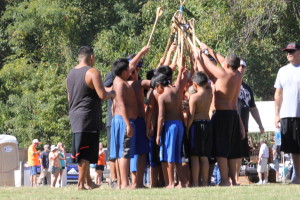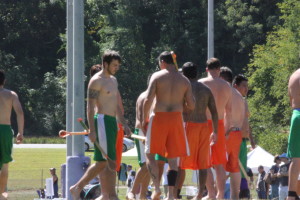Although it was a humid day, people packed in to witness the action that was about to take place. Some spectators looked puzzled at how the game was played, while others had expressions of awe. In the first game, I sat next to a family who were chanting, “Go! Go! Go!” as their boy was running up the field about to receive a pass.
I enjoyed this contest more than the men’s because several members of what seemed like family were out there on the field coaching and pushing them to play harder.
Cherokee stickball is a game that is showcased every Mountain Heritage Day season. On Saturday, September 24, a sort of scrimmage was held.
In modern competition, two teams consisting of about 12 guys, battle it out to see who can get to a score of 12. Keeping in touch with tradition, the game is played with a lacrosse-like wooden stick, and a ball that, to me, resembles a walnut. It can be brutal, and it is definitely competitive.

The young players unifying at the end of their matchup. Photo by: Marcus Smith
Before each game, the two teams go to opposite ends of the field, and one member of a team would do a warrior call while his teammates followed suit. The men on both teams repeated these calls until they met in the middle. Afterward, they dropped their sticks to the ground and waited for the referee’s signal to begin.
The referee kept a long tree branch in hand to break up long grapples, if necessary. At the end of the game, the competitors low-fived each other and placed their sticks up in the air united as to say they were one. If one is watching the game for the first time, it appears to be a combination of wrestling and lacrosse.
The first matchup was between young boys. It was a gentler game, but there were times where they were throwing each other around to obtain the ball and score. The second matchup between the men was more aggressive because guys would throw each other to the ground, and it looked as if some were choking each other.
Unlike traditional matchups, there were white men joining the Native Americans on each team.
When interviewing Tom Belt, Cherokee language program coordinator at WCU, a couple of days prior to the event, he told me that conflicts between the Cherokee Nation and others were historically solved with stickball.
“Rather than conduct a war, they said let’s have a game. A game in which those who are willing to play it will be the ones participating,” said Belt. “This game will not be so much of a game as it will be court. These games will not be played unless there is an issue.”
According to Belt, stickball would be played for the resolution of things such as trespassing on others’ lands to fish or hunt.

The Hummingbirds preparing for their scrimmage. Photo by: Marcus Smith
The Cherokee might say, “Our people need the game here. You’re out of bounds. If we win, you can’t come over here and hunt. If you win, you guys can come over here and hunt,” said Belt.
Belt said there are no rules in the game of Stickball except having a goal on each end. The game would be over if one team scored more or if other team was pushed off the field.
Belt told me that this idea of conflict resolution was called “The little brother of war” because it was much like “a condensed, small war.”
Although it was used to prevent actual warfare, people would still get seriously hurt or even die because, according to Belt, “they weren’t fighting over land. They were fighting over the biological understanding, the protocol” of keeping the natural balance of things like the killing of fish when it wasn’t fish season. The Native Americans felt they had to “defend the nature of how things work” making the games quite important.
Today, the games are for reminiscing on the proud Cherokee culture, as well as having a fun, competitive head-to-head.


